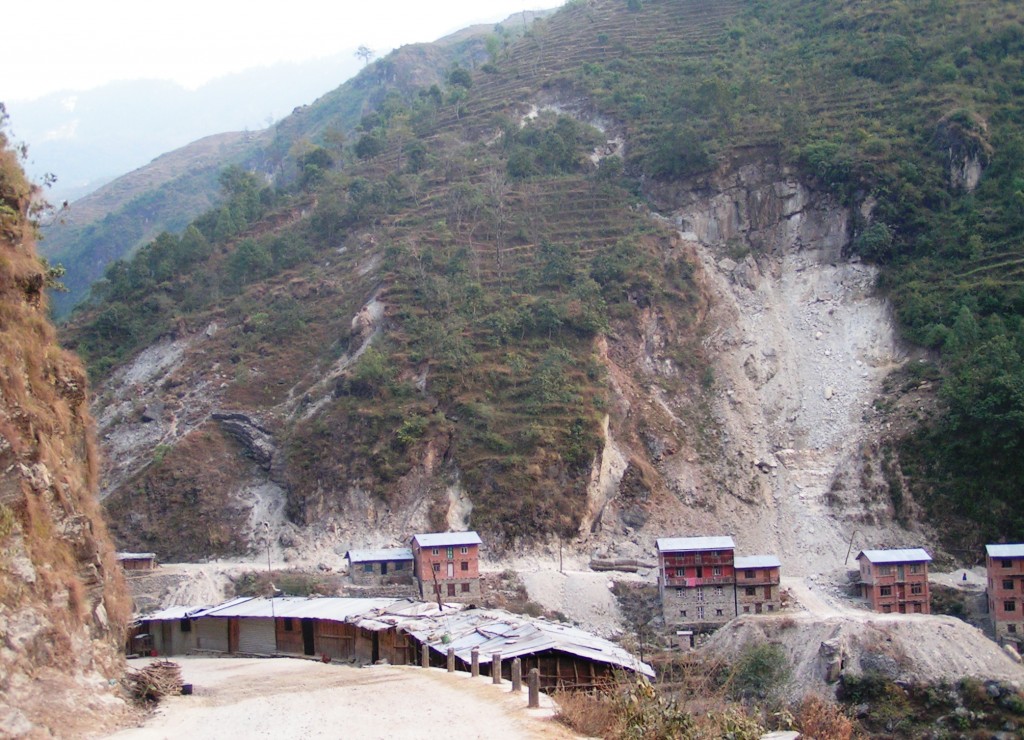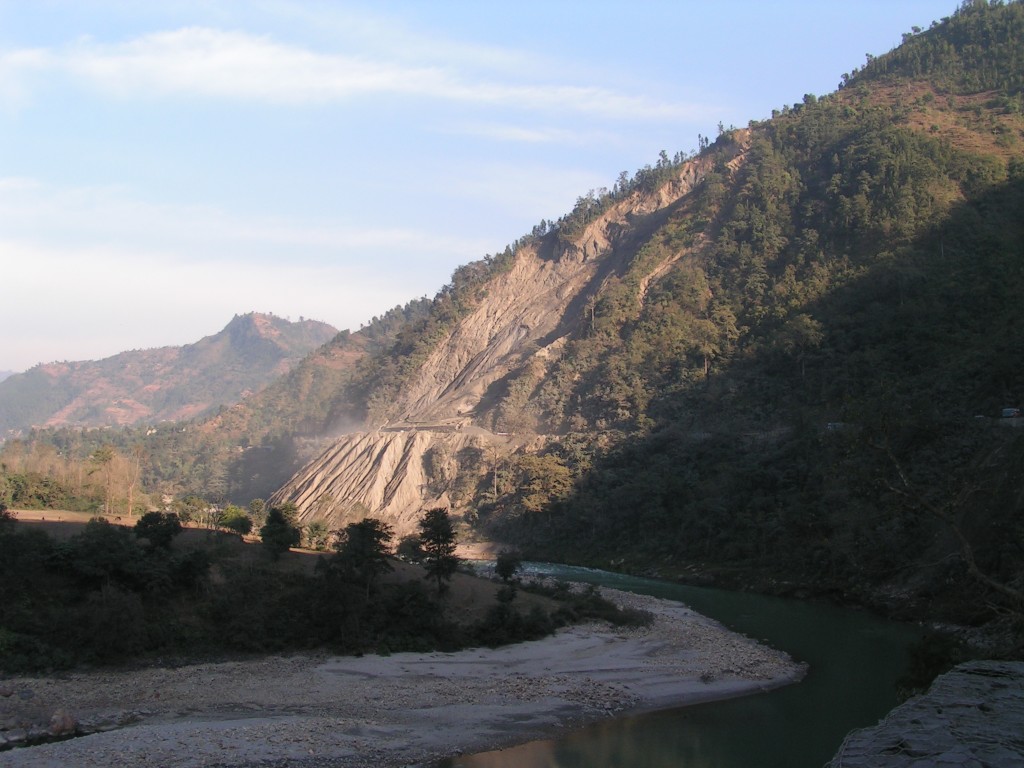10 March 2011
Landslides in Nepal
Posted by Dave Petley
 This week we held a workshop in Durham focusing on a small NERC-ESRC funded scoping project that we are currently running that is examining how to build resilience to a large earthquake in rural Nepal. We will posting a great deal more on the outcomes of this project on the IHRR blog over the next few weeks – I’ll keep you posted. Perhaps unsurprisingly, one of our key interests here is in the potential landslides that such an event might trigger, which are likely both to cause extensive losses and to represent a serious impediment to the rescue and recovery phase after the disaster. We chose Nepal for a number of reasons, not least the fact that we have been working there for the last decade or so. In this context it is really encouraging to see that the UK government’s announcement of future support to Nepal, made today during Alan Duncan’s visit to Kathmandu, is emphasising disaster risk reduction in general, and specifically in reducing losses from landslides and earthquakes. This is a very commendable step in the right direction.
This week we held a workshop in Durham focusing on a small NERC-ESRC funded scoping project that we are currently running that is examining how to build resilience to a large earthquake in rural Nepal. We will posting a great deal more on the outcomes of this project on the IHRR blog over the next few weeks – I’ll keep you posted. Perhaps unsurprisingly, one of our key interests here is in the potential landslides that such an event might trigger, which are likely both to cause extensive losses and to represent a serious impediment to the rescue and recovery phase after the disaster. We chose Nepal for a number of reasons, not least the fact that we have been working there for the last decade or so. In this context it is really encouraging to see that the UK government’s announcement of future support to Nepal, made today during Alan Duncan’s visit to Kathmandu, is emphasising disaster risk reduction in general, and specifically in reducing losses from landslides and earthquakes. This is a very commendable step in the right direction.
Our work in Nepal started with a large DfID-funded project that we undertook with an Engineering Consultant, Scott Wilson Ltd, that looked at landslide risk assessment for rural roads. The outputs from this project are available online here. A particularly interesting document is a manual that we wrote on best practice in this field – it is available for download for free from here (note that the pdf is 11 MB though).
As part of that study we wrote a paper that was published in the journal Natural Hazards on patterns in the occurrence of landslides in Nepal through time, based on a database that we built during the project. The paper showed that the occurrence of landslides is essentially cyclic, mirroring patterns in monsoon intensity, but that the occurrence of landslides has increased – i.e. in essence that the peak and trough of each cycle is moving upwards. We have maintained the database since then, so it is pertinent to provide an update. The graph below shows the both the number of people killed by landslides and the number of landslides that resulted in a fatality from 1980 to the present, based on our database. Note that the data are smoothed to remove the noise using a simple five year running mean:
 The cyclic pattern is clear, with a peak around about 1984-5 and again in about 2001-2, and a trough in about 1993-4. At the time that we undertook the project we were a little alarmed at the rapidly increasing trend in landslide occurrence, but the data suggests that this is at least in part due to the cyclicity. However, the difference between the 1984-5 and the 2001-2 peaks is all too apparent. We should now be in the declining trend again – and to at least some degree this is the case, but landslide occurrence, and the impact of them remains stubbornly high. It should also be remembered that whilst the importance of loss of life cannot be underestimated, the main landslide impact for Nepal is economic and social. This increasing trend is clearly undesirable and needs to be addressed.
The cyclic pattern is clear, with a peak around about 1984-5 and again in about 2001-2, and a trough in about 1993-4. At the time that we undertook the project we were a little alarmed at the rapidly increasing trend in landslide occurrence, but the data suggests that this is at least in part due to the cyclicity. However, the difference between the 1984-5 and the 2001-2 peaks is all too apparent. We should now be in the declining trend again – and to at least some degree this is the case, but landslide occurrence, and the impact of them remains stubbornly high. It should also be remembered that whilst the importance of loss of life cannot be underestimated, the main landslide impact for Nepal is economic and social. This increasing trend is clearly undesirable and needs to be addressed.
Of course, the underlying question is that of the likely causes of these trends. This is addressed in the paper that we wrote in Natural Hazards, and still applies here. Whilst it is tempting to suggest that it is driven purely by climate change, this is unlikely to be the case. That is not to say that climate change is not important in Nepal – it is a country that is immensely vulnerable to the impacts of the changing climate – but there are a raft of other changes occurring in that country. Key amongst these are population growth, increased urbanisation and land use change. However, I still maintain that the most important may be the changes that are occurring in rural communities as populations relocate from higher slopes to live beside roads in the lower valleys, thereby increasing their vulnerability to landslides. This is why the DfID project that we undertook is so important, and why I remain deeply frustrated that we don’t choose road alignments properly. This would be so easy and cheap to do, and would genuinely reduce loss of life.
For those who are interested in more detail on this topic, I heartily recommend the wonderful thesis of Katie Oven, a PhD student in Durham who looked at comm unity vulnerability to landslides in Nepal. This thesis is available for download from our ethesis repository (note that the file is 18 MB):
Comments and thoughts welcome.



 Dave Petley is the Vice-Chancellor of the University of Hull in the United Kingdom. His blog provides commentary and analysis of landslide events occurring worldwide, including the landslides themselves, latest research, and conferences and meetings.
Dave Petley is the Vice-Chancellor of the University of Hull in the United Kingdom. His blog provides commentary and analysis of landslide events occurring worldwide, including the landslides themselves, latest research, and conferences and meetings.
Nepal’s ambassador to UK visits Durham University and meets Dave Petley and Katie Oven
http://www.nepalnews.com/archive/2011/mar/mar10/news16.php
The IRNH Workshop attandant from nepal were not under exchange program but the professional from pioneer nepales organization dedicated on DRR at nepal i. e National Society For Earthquake technology-Nepal (NSET) as a partner for the planned project for nepal.